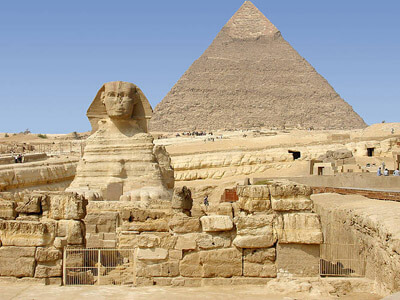
Dr. Zahi Hawass: Intrigue in the Background of Egyptology (2.): Sphinx Fingers in the Dry
 8
8
 30. 09. 2016
30. 09. 2016

Let's go back to Dr. Hawassovi a Sphinx The working framework described above (the influence of organizations) was clearly functional during April 2009, when Hawass said: Under my leadership, the Supreme Council for Monuments is working to lower the groundwater levels around monuments across Egypt. We have completed a USAID-funded effort to drain Karnak and Luxor, and work is underway at many other sites. One of the greatest recent successes has been the development of a system that prevented the Great Sphinx's paws from getting wet in Giza.
Surprisingly, Dr. Hawass in his report The Story of the Sphinx: Perhaps the most important result of the drainage project was that it allowed us to finally sleep with speculation about the mysterious underground tunnels and rooms carved into the rock under the Sphing ancient civilizations. For many years, I debated with people like John Anthony West, Robert Bauval and Graham Hancock. They say that the surviving descendants of the lost civilization of 10000 BCE buried their secrets under the Sphinx. These people also say that the erosion of the Sphinx is caused by water, and this necessarily means that its age would fall far beyond the Old Kingdom (the Old Kingdom of Egypt). None of their theories are based on truth. Their supporters insist that we drill into the subsoil to find these hidden chambers. I have always refused to allow such projects in the past because there was no scientific evidence for such a thing. Even because such drilling was an essential part of our work to protect the Sphinx from groundwater. Although we eventually drilled close to the statue, we found that there were no hidden corridors or chambers.

Dry feet
As always, this is Hawasse's usual hype in which he tries to highlight his greatest achievements. Unfortunately, these are unfortunate and unscientific conclusions. There are several studies, such as the 1992 seismological work or the 1996 Schor radar, which clearly show geological anomalies (clear cavities). Some are (probably) of natural origin, but others are beyond the reach of nature.
One might argue that this all doesn't make sense (what Hawass says). Hawass specifically tested the presence of groundwater in these specific areas, in which (as he himself stated) he was absolutely certain that there were no cavities, natural or artificial hidden corridors or chambers, they are not. Nevertheless, Hawass drilled in the area around the Sphinx… (There is something rotten in Hawass's words.)
Hawass report The arrival of the Sphinx is also at odds with the findings of the scan from Dr. Abbase and his team published in NRIAG (National Research Institute of Astronomy and Geophysics) conducted in 2007.
Instead of dealing with factual comments on a fellow academic who published his results in a scientific journal, Hawass, for reasons that clearly have nothing to do with science, hits people like West, Bauval and Hancock. And why the older Sphinx (according to Hawass) determined on the basis of water erosion has nothing to do with the presence of chambers under the monument, it is also not clear. But with regard to other unscientific leaps of Dr. Hawasse shouldn't be surprised either.
When we look closely at his report, we will find more interesting things. We know that at the beginning of 2008 The Supreme Council for Monuments worked with Cairo University of Engineering - Center for Archeology and the Environment. They drilled a total of 4 holes with a diameter of 10 centimeters and a depth of 20 meters into the bedrock of the Sphinx. They sent a camera into each of the holes to examine the geological subsoil.
Report The Story of the Sphinx contains several important details, which Hawass should rather engage (in depth) than when creating a smoke screen.
A separate scientific report contains information that more than 260 m has been pumped3/ h of water through drainage pipes. It gives 6240 m3/ day or 6,2Gl / day (gigaliters per day). For comparison: one Olympic pool contains 2,5Gl of water. In short, this would mean that they drained 3 pools of water every day from the area below the Sphinx. The Sphinx itself would fit in the Olympic pool. The report goes on to say that it managed to reduce the water level in the area in front of the Sphinx to about 70% of the original volume. But the moment: a total of 33 checkpoints were set up to monitor the movement of the Sphinx's body for one month. Measurements confirmed that the Sphinx is stable.
Now I'm really confused about such a huge amount of water that had to be drained. It can be deduced from this that there is at least one cavity the size of a (small) pool, which is (probably) constantly filled with water. Something like an underground lake. The report itself shows that Hawass is lying.
One source, who saw a confrontation between me and Hawass's report, went so far as to claim that Hawass, in collaboration with Mark Lehner, had indeed found the lake many years ago. The lake is located below the entire plateau. The area is surrounded by a concrete wall (its construction began in 2002). He added that in his opinion, these projects are a preparation for exploring the underground world under Giza.
... next week ...
[Hr]
Back to: Dr. Zahi Hawass: Intrigue in the Background of Egyptology (1.)





